-
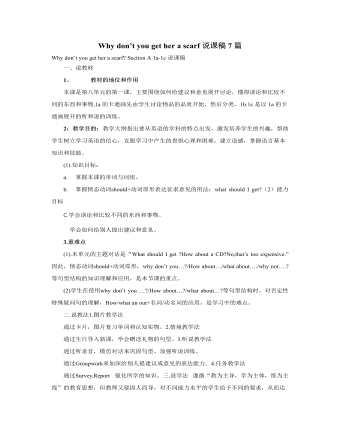
人教版新目标初中英语八年级下册Why don’t you get her a scarf说课稿7篇
[设计意图: 该环节可让学生展示自我,拓宽运用英语能力,把所学的知识在实际交流中进行运用,实现新课程倡导的“为用而学, 在用中学,学了就用”,从而提高学生综合运用英语的能力。选择母亲节来临为母亲选择礼物这一话题也是借此机会对学生进行感恩教育,并在学生的热烈讨论中告诉学生gift can’t be everything, everything can be a gift.使学生的情感得到升华。] Step9 Summary T: What have we learned in this class? Presents/ Gifts Comments Suggestions Album----special Why don’t you … Bicycle----useful Why not … +V原形 Calendar----interesting How about … Scarf----personal What about … +V-ing/ 名词 [设计意图:此环节的设计,有助于理清脉络,进一步巩固所学知识。] Step10 Homework 1. listen to 1b (do 1b and imitate ) 2. Write down your dialogue 3. Surf the internet about the differences of gift giving between China and foreign countries. [设计意图:作业1听力,由于1b听力和后面的2a相似,所以课堂上不再重复做,将其留做课后作业,上课下课时刻关注学生听力能力的培养和训练。2是将学生课堂上的说落实到课后的写。3是让学生通过自主学习,了解中西方文化的差异。分层次布置作业,体现出因材施教的教学理念。]

人教版新目标初中英语九年级上册I like music that I can dance to教案
教学目标: 1. Express preferences2. Talk about one’s likes and dislikes and the reasons3. Learn to express one’s opinions 4. Learn to write a reply 语言功能: 1) Talk about one’s preferences, using t he relative clause2) Talk about people’s likes and dislikes and the reasons3) Talk about opinions语言结构: Relative clauses with that and who语言目标:What kind of music do you like?I like music that I can sing along with.I love singers who write their own music.We prefer music that has great lyric.重点词汇及短语:heart, photography, interest, class, whatever, miss, okay, expect, sweet, taste, itself, laboratory, cancer, increase, biscuit, main, care, prefer… to…, remind somebody of …, dance to, sing along with, be sure to, interest somebody, make somebody adj., to be honest, suit somebody, on display, catch up教学重难点:What do other people think of the different kinds of things? How to express one’s opinions? 学习方式:讨论,合作学习情感目标:通过本单元的学习,能提高学生的艺术鉴赏能力和审美情趣,并引导学生养成健康的饮食习惯。课时安排5课时第一课时:Section A: 1a-2c第二课时:Section A : 3a-4第三课时:Section B:1-2c, Self check2第四课时:Section B: 3a-4, Self check1第五课时:Self check ReadingI like music that I can dance to.

人教版新目标初中英语九年级上册I used to be afraid of the dark教案
内容提示1.本单元主要内容是学会used to结构。Used to +动词原形表示过去经常、以前常常,只用于过去式中,用来表示现在已不存在的习惯或状态。例如:They used to play football together.他们过去常在一起蹋足球。(现在不在一起踢了)2.used to的疑问形式和否定形式为Did you use to…?和I didn’t use to… 也可以用Used you to…?和I used not to…但现在多使用前者。例如:Did you used to swim in the river? 你过去常在河里游泳吗?I didn’t use to play the piano. 我以前并不经常弹钢琴。教学目标一、学习目标(Language Goal) 1.学会陈述自己过去常做的事情。2.学会陈述自己过去的爱好等。3.能够表达自己现在和过去在外表、性格、娱乐等方面的变化。4.能够表达朋友、家人等现在和过去的变化。二、语言结构(Language Structures) 1.I used to be short when I was young. 我年轻时个子很矮。 2. —Did you use to have straight hair? 你过去是直发吗?—Yes, I did. 是的。 3. —Did you use to play the piano? 你过去弹钢琴吗?—No, I didn’t. 不,我不弹。 4.I used to be afraid of dark. 我过去害怕黑暗。 5.I’m terrified of the snakes. 我害怕蛇。

人教版新目标初中英语九年级上册Where would you like to visit教案2篇
The First PeriodⅠ.Teaching Aims and DemandsKnowledge Objects(1) Key Vocabularytiring, educational, fascinating, thrilling, peaceful, exotic, trek, jungle, take it easy, explore, historic, site(2) Target LanguageWhere would you like to go on vacation?I’d like to trek through the jungle, because I like exciting vacations.2. Ability Objects(1)Train students to talk about places they would like to visit with the target language.(2)Train students to describe vacations with different adjectives.(3)Train students' listening skill.3. Moral Object,It′s more interesting to go on vacating somewhere instead of staying at home.Ⅱ. Teaching Key Points1. Key Vocabularytiring, educational, fascinating, thrilling, peaceful, exotic, trek, jungle, take it easy, explore, historic, site2. Target LanguageTalk about different places with the target language.Ⅲ. Teaching Difficult Points1. Describe vacations with different adjectives.2. Talk about different places with the target language.Ⅳ. Teaching Methods1. Teaching by illumination2. Teaching by doing chain drills3. Teaching by pairworkⅤ. Teaching Aids1. A tape recorder2. Some pictures of different places with famous views
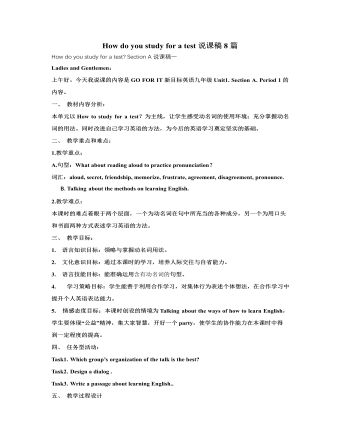
人教版新目标初中英语九年级上册How do you study for a test说课稿8篇
教学反思:这是学生升入初三的第一节课,学生学习热情很高,通过这一课时的学习,学生掌握了语言目标中所要求的知识重点、难点和语言技能,如by dong, practicing doing ,too……to,现在完成时态,动名词短语做主语及提建议的几种方式,但是有部分学生由于基础较差,还需要从培养学生学习兴趣入手,真正实现教育面向全体学生。在教学中采取的具体办法由:个别辅导,互助学习,留不同层次夫人作业,争取让每一位学生都吃饱而不掉队。How do you study for a test?Two periodsSection BGoals●To listen about learning English●To talk about learning English●To read about learning EnglishProceduresWarming up by reading to the recordingHello, everyone. To begin with, let’s listen and read to the recording of the text HOW DO YOU LEARN BEST? That is, read aloud to the tape, as fast as the tape goes, as clearly as the native reader reads. OK? Here we go!My cat speaks English. Sometimes my cat comes to me and tells me that she is hungry. Or that her leg hurts. How does my cat tell me these things? I don't speak pussy-cat language.1a Reading and checkingLearning English can be both easy and difficult. What things are easy for you? And what things are difficult for you? Now turn to page 5, read the list on the top and check √the statements that are true for you.1b Making a listYou have read and checked the statements true for you. Now think and make a list of other things difficult for you, too.
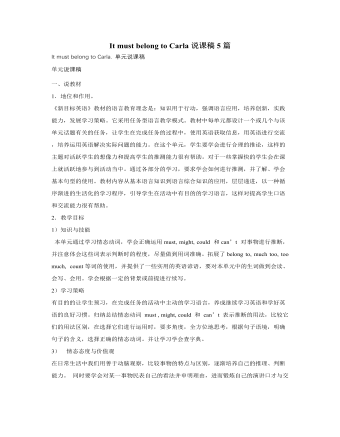
人教版新目标初中英语九年级上册It must belong to Carla说课稿5篇
二、教学目标: 1. 知识目标:要求学生掌握使用表示猜测的情态动词。2. 能力目标:让学生做课堂的主人,同时培养他们掌握一些行之有效的学习方法,优化学习效果。3. 情感目标:让学生爱上英语课堂活动,鼓励他们在课堂上进行合作交流。4.学习策略目标:设法使学生掌握使用英语进行交流,学习积极参与班级活动.三、教学分析:1. 说教法:1)任务型教学法:给学生三项任务, 让学生使用这些情态动词来完成这些任务。使他们在任务中学习英语。2)情景教学法:创造足够的交际环境刺激学生的视听能力,使他们能够更好的理解这些情态动词。以培养他们的听和会话能力。3)交易际教学法:学生可以通过俩俩对话或小组对话来掌握这些情态动词。2. 说学法:1)学生要善于把握机会,用英语进行沟通,大胆实践。
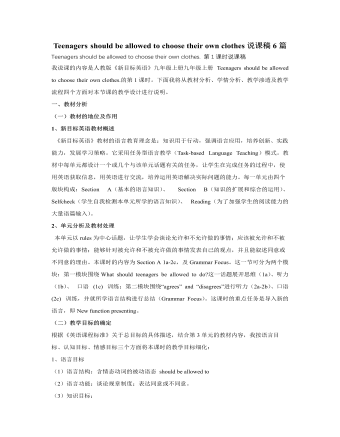
人教版新目标初中英语九年级上册Teenagers should be allowed to choose their own clothes说课稿6篇
二、教材分析本课时主要是以听和说的方式来谈论一些家庭和学校的“规矩和制度”,知道那些时可以做的,那些是不可以做的,让学生先从口头上了解这些规矩和制度,为后面的学习做好准备。三、教学的目的和要求1. 掌握短语be strict with sb.的用法,并介绍be strict in sth.的用法;2. 学生能够根据所学的知识,了解用什么方式/句型来制定规章制度。3. 多听,提高学生的习愿望,敦促学生开口说英语,用本课所学的知识来表达自己的意见。四、教学重点和难点1. 如何正确使用be allowed to do…这一句型(在不同时态中的被动语态运用)。2. 如何获得听力技巧及口语技能的提高。五、教学过程T—teacher S—studentS s—students Bb—blackboardStep 1 Warming up Check their homework first, and see if the Ss can make sentences by using the rules in 4, Section A. If possible, try to give some help.

人教版新目标初中英语九年级下册Could you please tell me where the restrooms are教案
Step Ⅰ RevisionCheck homework. Ask a few students to read the article in 3a.Then ask a few students to read their guides.Step Ⅱ Part 1Look at the words in the box. Ask a student to read them. Make sure the students understand the meaning of the words. You are to fill in the blanks with the words. In some cases, students may need to use another form of the word, for example adjusting for tense or subject/ verb agreement.Ask students to fill in the blanks on their own.Check the answers. Step ⅢPart 2Go through the instructions with the class.Look at the example with the students.Ask students what the answer would be.Ask a student to read the question and answer it.Excuse me, could you tell me where the bank is, please?The bank is across the street from the shopping malt.Get students to complete the work in pairs.Check the answers. Ask a few students to read their questions.Step Ⅳ Just for Fun!Ask all the students to read the conversation. Ask: What is funny about this cartoon? Help students to explain. A Martian is a person from the planet Mars.There is no such thing as Martian food on Earth, and the clerk looks silly because he is trying to think of where there is a Martian restaurant.Invite some pairs of students to present this conversation to the rest of the class.Step Ⅴ Summary and HomeworkIn this class, we’ve done much writing practice using the key vocabulary words and the target language presented in this unit. After class, please finish the questions in 2 in your exercise books. Then finish the exercises on pages 47~48 of the workbook as well.The Seventh Period Ⅰ Teaching Aims and Demands1. Knowledge Objects(1) Key Vocabularyimage, adventure, jealousy, hero, crime, journey, brave, no longer, show interest in, take it easy, become interested in, plain looks(2)Text:Grown-ups like cartoons, too.2. Ability Objects(1) Fast-reading to get a general idea of the text.(2) Careful-reading to get the detailed information in the text.

人教版新目标初中英语九年级下册I’ll help clean up the city parks教案
Talk about offering help (P60)I’ll help clean up the city parks.A: I’d like to work ...B: You could help ...Talk about ways to tell people about the Clean-Up Day (P61)We need to ...We can’t ...I’ll ...Talk about the work the volunteers do (P62)These three students all volunteer their time to help other people.Somebody loves to ... / helps ... / plans to ... / wants to ...A: What do you like doing?B: I like ... A: What kind of volunteer work do you think I could do?B: You could ...1. 重点词汇advertisement, fix, repair, pleasure, blind, deaf, shut, carry, specially, fetch2. 认读词汇hunger, homeless, cheer, clean-up, sign, establish, major, commitment, elementary, veterinarian, coach, similar, call-in, strategy, disabled, organization, unable, support, appreciate, donation, part of speech, pronoun, adverb, preposition, conjunction, donate, Jimmy, Sally3. 词组clean up, cheer up, give out, put off, set up, think up, take after, fix up, give away, put up, hand out, work out, at once

人教版新目标初中英语九年级下册You’re supposed to shake hands教案
教学目标:1. 掌握本单元一些重点词汇的写法和用法。2. 学会自如谈论餐桌礼仪。Step 1 RevisionAsk some students to retell the customs at the table in France in the passage in 3a.Step 2 Self checkPart 1. Fill in each bland with the correct word given. Students do the exercises by themselves at first. Then check the answers. Ask the students to comprehend the sentences and help them point out uses of some words, like “arrive (at / in) sw., spend time / money on sth , spend time / money (in) doing sth.”Part 2. Read about Fan Ling’s experience in a western restaurant. Understand the passage. Point out some key points in the passage.1. be / get used to doing sth. 习惯做某事2. begin with = start with 以….开头3. crowd v. 挤满,塞满 the crowd 人群 crowded adj. 拥挤的Then students discuss about how she would solve her problem. Ask some to share their stories with others.Part 3. Complete the crossword by looking at the sentences on the left. Then check the answers.
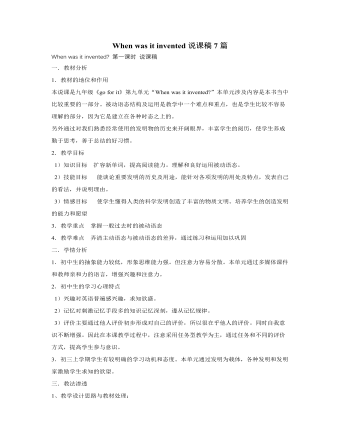
人教版新目标初中英语九年级下册When was it invented说课稿7篇
《新目标英语》中的具体语言目标是通过各种各样的Tasks来实现的;学生需要运用具体而特定的行动来完成一定的交际任务。整个教学过程中,各种语言结构与语言功能与不同的学习任务有机的结合。任务活动所谋求的效果不是一种机械的语言训练,而是侧重在执行任务中学生自我完成任务的能力和策略的培养;重视形式在完成任务过程中的参与和在交流活动中所获得的经验。因此本节课我将始终引导学生通过完成具体的任务活动来学习语言,让学生为了特定的学习目的去实施特定的语言行动,通过完成特定的交际任务来获得和积累相应的学习经验,让学生在用中学,在学中用。 2、教学原则 l 活动性原则 提倡学生主动参与,体验,交流,合作,探究等多种学习。 l 合作性原则 以学生为主体,师生合作,生生合作,体现教与学的互动,交往。 l 任务型原则 任务驱动—激发动机;任务完成—激励学习积极性;执行任务—培养责任 心和合作精神。 l 情感性原则 激发学生学习英语的兴趣和始终保持良好的学习情绪。
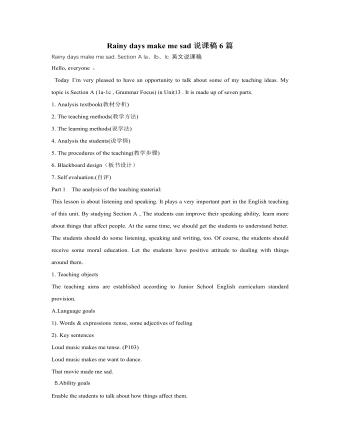
人教版新目标初中英语九年级下册Rainy days make me sad说课稿6篇
Today I’m very pleased to have an opportunity to talk about some of my teaching ideas. My topic is Section A (1a-1c , Grammar Focus) in Unit13 . It is made up of seven parts.1. Analysis textbook(教材分析)2. The teaching methods(教学方法)3. The learning methods(说学法)4. Analysis the students(说学情)5. The procedures of the teaching(教学步骤)6. Blackboard design(板书设计)7. Self evaluation.(自评)Part 1 The analysis of the teaching material:This lesson is about listening and speaking. It plays a very important part in the English teaching of this unit. By studying Section A , The students can improve their speaking ability, learn more about things that affect people. At the same time, we should get the students to understand better. The students should do some listening, speaking and writing, too. Of course, the students should receive some moral education. Let the students have positive attitude to dealing with things around them.1. Teaching objectsThe teaching aims are established according to Junior School English curriculum standard provision.A.Language goals 1). Words & expressions :tense, some adjectives of feeling 2). Key sentences Loud music makes me tense. (P103)Loud music makes me want to dance.That movie made me sad.B.Ability goals Enable the students to talk about how things affect them.Emotion & attitude goals Enable the students to understand the effect of things upon them.
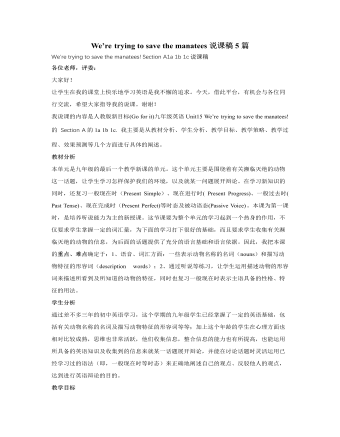
人教版新目标初中英语九年级下册We’re trying to save the manatees说课稿5篇
教材分析本单元是九年级的最后一个教学新课的单元。这个单元主要是围绕着有关濒临灭绝的动物这一话题,让学生学习怎样保护我们的环境,以及就某一问题展开辩论。在学习新知识的同时,还复习一般现在时(Present Simple)、现在进行时( Present Progress)、一般过去时( Past Tense)、现在完成时(Present Perfect)等时态及被动语态(Passive Voice)。本课为第一课时,是培养听说能力为主的新授课。这节课要为整个单元的学习起到一个热身的作用,不仅要求学生掌握一定的词汇量,为下面的学习打下很好的基础,而且要求学生收集有关濒临灭绝的动物的信息,为后面的话题提供了充分的语言基础和语言依据。因此,我把本课的重点、难点确定于:1、语音、词汇方面:一些表示动物名称的名词(nouns)和描写动物特征的形容词(description words);2、通过听说等练习,让学生运用描述动物的形容词来描述所看到及所知道的动物的特征,同时也复习一般现在时表示主语具备的性格、特征的用法。

《过秦论》说课稿 2021—2022学年统编版高中语文选择性必修中册
三、教学方法为了突出重点,突破难点,完成教学目标,选择行之有效的教学方法是非常关键的。根据课程标准的要求和本节课的特点,为了关注学生的个体差异和不同的学习需求,充分调动学生学习的积极性,培养学生阅读和分析文章的能力,我主要采用以下的教学方法:1、悬念导入法。用悬念导入能激发起学生对文言文阅读的兴趣,充分调动学生学习的主动性。2、根据教师主导作用与学生主动性相结合的原则,选择了以语言传递信息为主的方法,讲授法。四、学法通过初中的学习,学生对古文知识已经有了一定的掌握,但是对这种古代散文比较少见,特别是叙史和议论结合的写法更是陌生。所以学习这篇课文的时候,通过反复地诵读,分析句型,对比句型的意思,达到疏通文意,这样,学生通过朗读理解法、质疑提问法、自主讨论探究法能复述课文,了解文章层次,理解文章主旨含义。
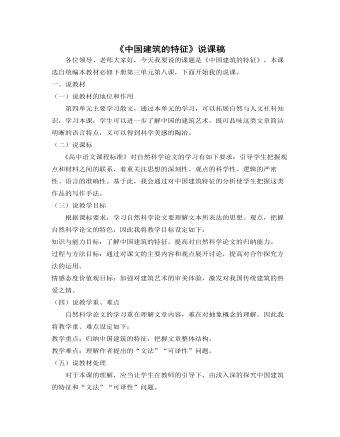
《中国建筑的特征》说课稿 2021—2022学年统编版高中语文必修下册
(二)初读课文,整体感知首先教师对作者进行简单介绍,再要求学生速读课文,让学生初步感知课文内容,归纳全文思路,边读边思考PPT上的问题。问题:全文可以分成几部分?此环节意在激发学生的学习主动性,培养学生的自学能力。读毕,我会对学生的自学情况进行检查反馈,鼓励学生踊跃发言,说出自己理解的写作思路,最后教师对学生的答案进行概括和总结,此环节能够让学生对中国建筑的特征整体把握,夯实学习本文的基础,同时感知课文,理清文章脉络,实现长文短教,为析读本文作好铺垫。(三)析读课文,质疑问难此环节是教学的重要阶段,在这里,我会以新课标为基准,做到阅读指向每一个学生的个体阅读,同时在教学过程中遵循启发性,循序渐进性的原则。此环节运用小组合作学习法、讨论法和问答法分析中国建筑的特征。同学每四人为一小组讨论PPT上展示的问题。
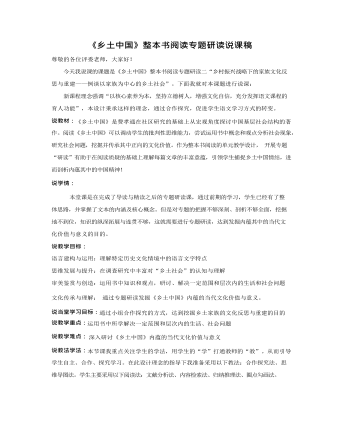
《乡土中国》说课稿 2021-2022学年统编版高中语文必修上册
活动一:整体感知,梳理要点新修订《课程标准》指出:重视学生的思维发展与提升,如直觉思维、形象思维、抽象思维等。为此,我设计了“梳理要点、绘制思维导图”两个部分,引导学生在阅读中整体感知文本。1、梳理章节要点,明确内容要素《家族》:以西洋家庭特点为对照,分析中国乡土社会家庭的特点。《男女有别》:主要讨论乡土社会感情定向的问题,偏向同性交往,遏制男女交往。2、展示思维导图,凸显整体关联引导同学制作多种思维导图:流程图式、树状图式、爪形图式活动二:走进文本,深化认知新修订《课程标准》指出:学会语文运用的方法,有效地提高语文能力,并在学习语言文字运用的过程中促进方法、习惯及情感、态度与价值观的综合发展。所以在教学中我引导学生掌握整本书阅读的基本方法,即以速读、跳读的方式地毯式地搜索书中关于“中西家庭差别”的内容,得出乡土家族的六个方面的特点,学生分别结合生活中的现象阐述了这六个方面的特点在生活中的具体体现。
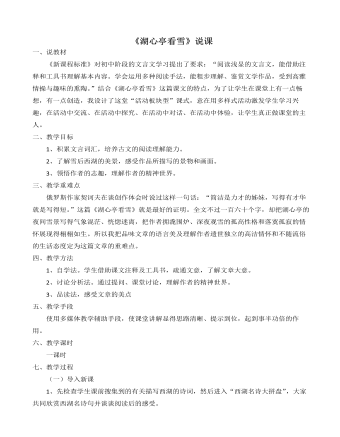
部编版语文九年级上册《湖心亭看雪》说课稿
一、说教材《新课程标准》对初中阶段的文言文学习提出了要求:“阅读浅显的文言文,能借助注释和工具书理解基本内容。学会运用多种阅读手法,能粗步理解、鉴赏文学作品,受到高雅情操与趣味的熏陶。”结合《湖心亭看雪》这篇课文的特点,为了让学生在课堂上有一点畅想,有一点创造,我设计了这堂“活动板块型”课式,意在用多样式活动激发学生学习兴趣,在活动中交流、在活动中探究、在活动中对话、在活动中体验,让学生真正做课堂的主人。二、教学目标1、积累文言词汇,培养古文的阅读理解能力。2、了解雪后西湖的美景,感受作品所描写的景物和画面。3、领悟作者的志趣,理解作者的精神世界。三、教学重难点俄罗斯作家契诃夫在谈创作体会时说过这样一句话:“简洁是力才的姊妹,写得有才华就是写得短。”这篇《湖心亭看雪》就是最好的证明。
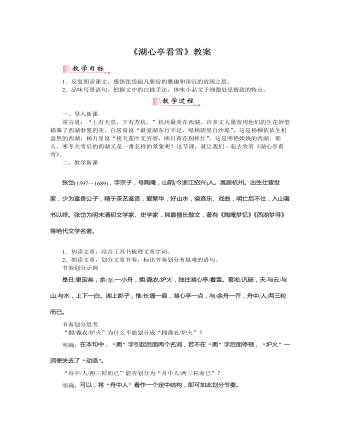
部编版语文九年级上册《湖心亭看雪》教案
一、导入新课常言道:“上有天堂,下有苏杭。”杭州最美在西湖。许多文人墨客用他们的生花妙笔描摹了西湖春夏的美。白居易说“最爱湖东行不足,绿杨阴里白沙堤”,这是杨柳依依生机盎然的西湖;杨万里说“接天莲叶无穷碧,映日荷花别样红”,这是明艳妖娆的西湖。那么,寒冬大雪后的西湖又是一番怎样的景象呢?这节课,就让我们一起去欣赏《湖心亭看雪》。二、教学新课目标导学一:认识作者,了解作品张岱(1597—1689),字宗子,号陶庵,山阴(今浙江绍兴)人。寓居杭州。出生仕宦世家,少为富贵公子,精于茶艺鉴赏,爱繁华,好山水,晓音乐、戏曲,明亡后不仕,入山著书以终。张岱为明末清初文学家、史学家,其最擅长散文,著有《陶庵梦忆》《西湖梦寻》等绝代文学名著。目标导学二:朗读训练,通文顺字1.初读文章,结合工具书梳理文章字词。2.朗读文章,划分文章节奏,标出节奏划分有疑难的语句。节奏划分示例
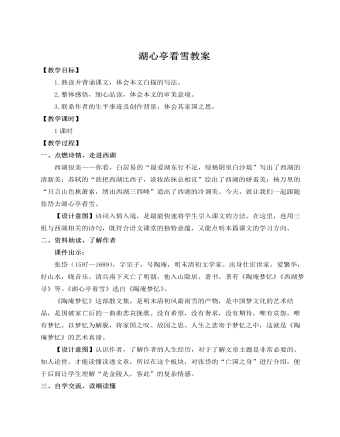
人教部编版语文九年级上册湖心亭看雪教案
《湖心亭看雪》是一篇审美型古文,其具体体现在文中的雪景和“痴”情的部分。尤其是文中“雾凇沆砀,天与云与山与水,上下一白,湖上影子,惟长堤一痕、湖心亭一点、与余舟一芥、舟中人两三粒而已”这文学作品中白描的经典之句,从整体到局部,由大到小,由远到近,实写与虚写交融,写出了作者视野的开阔,天地的空旷,人物的渺小,给人一种天地之大、人物之小、人于茫茫天地间如沧海一粟的深沉感慨。如此,给学生的审美和鉴赏提供了另外一种全新的方向:突出主体、不求细致、朴实无华。这种白描写法,可使景物描写的内涵更丰富,更能使情节发展和人物性格变化融合到环境中,使语言更有嚼头。白描用于写人,只需三言两语即可勾画出人物的外貌和神态,使读者如见其人,能洞穿人物骨髓,由貌触及本质、灵魂;能传神表达人物内心,展现情操品质;能使人物内心情感的表露更准确。这样的审美能力对学生创造更有真情实感的作品有更深远的影响。[疑难探究]
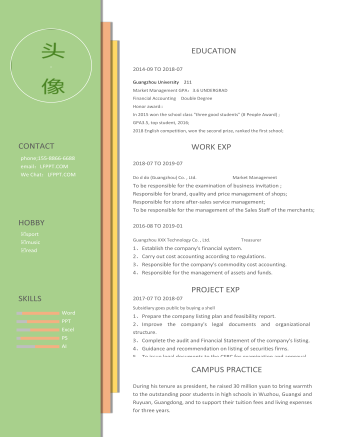
英文简历+中文简历
GuangzhouUniversity 211Market Management GPA:3.6 UNDERGRADFinancial Accounting Double DegreeHonor award::In 2015 won the school class"three good students" (# People Award) ;GPA3.5, top student, 2016;2018 English competition, won thesecond prize, ranked the first school;
